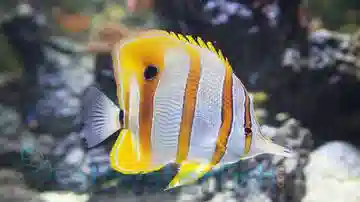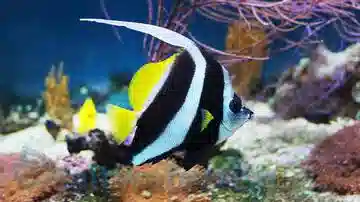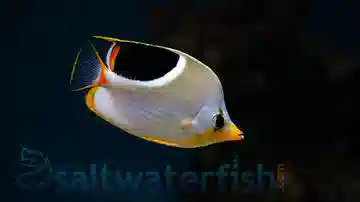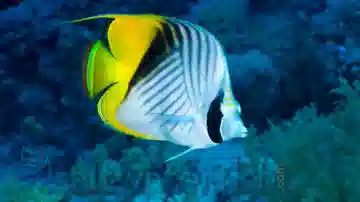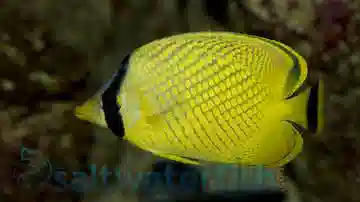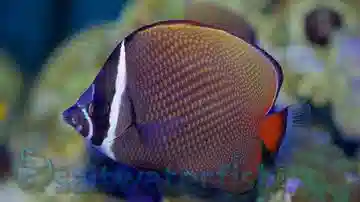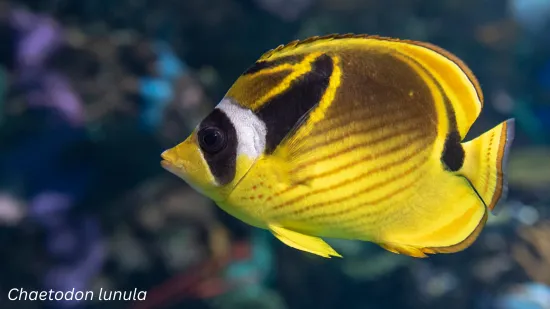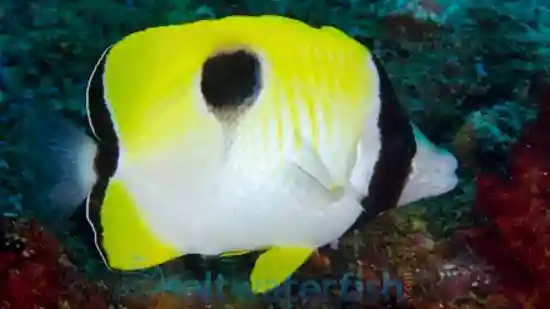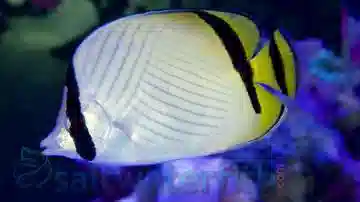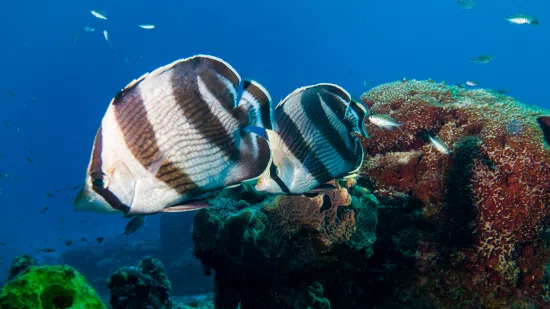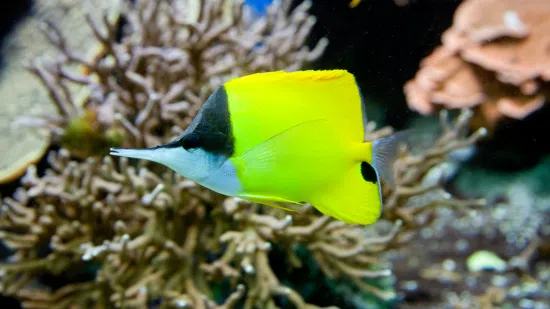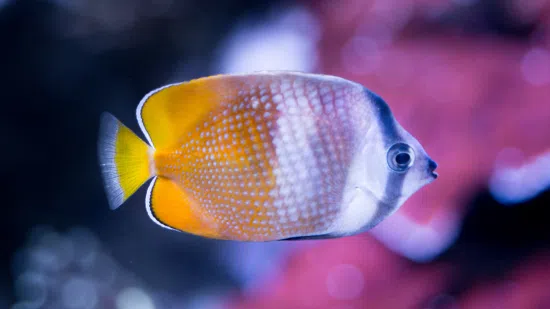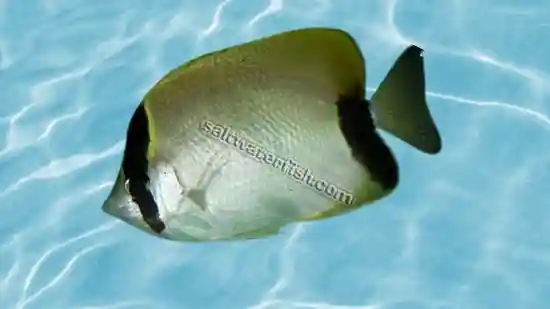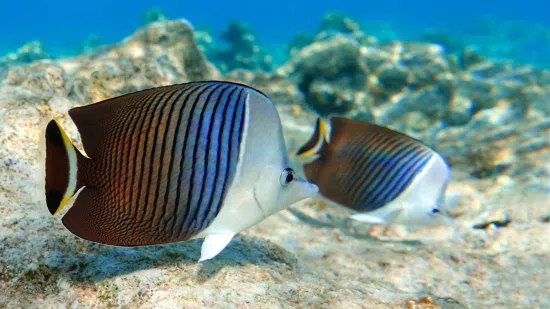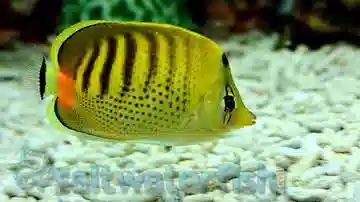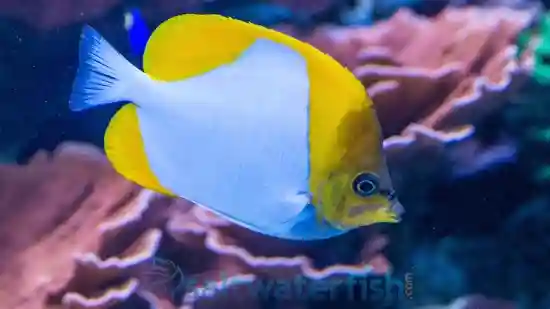Butterflyfish In Saltwater Aquariums: FAQ
Butterflyfish are some of the most graceful and colorful reef fish, but their diet can vary greatly depending on the species. In the wild, butterflyfish feed on coral polyps, small invertebrates, algae, and plankton. In a saltwater aquarium, their diet must be adapted to what is both available and sustainable for long-term care.
General diet for butterflyfish in aquariums:
Frozen foods: Mysis shrimp, brine shrimp, krill, clam, and finely chopped seafood are staples that most butterflyfish accept.
Prepared foods: High-quality marine pellets and flakes, especially those enriched with spirulina, omega-3s, or garlic, support immune health and coloration.
Algae & greens: Some species graze on algae or nori sheets clipped to the tank.
Specialized feeding (coral-eating species): Certain butterflyfish, such as Copperband Butterflyfish (Chelmon rostratus), often require live foods or are difficult to wean onto prepared diets.
Feeding frequency:
Offer 2–3 small meals daily. Butterflyfish have small stomachs and graze frequently in the wild, so multiple feedings keep them active and healthy.
Species considerations:
Easier feeders: Longnose Butterflyfish (Forcipiger flavissimus), Pyramid Butterflyfish (Hemitaurichthys polylepis), and Klein’s Butterflyfish (Chaetodon kleinii) adapt well to frozen and prepared foods.
Challenging feeders: Copperband Butterflyfish may refuse prepared foods, so they’re best for experienced aquarists.
One Saltwaterfish.com reviewer of the Copperband Butterfly shared: “Got a smaller guy for my 65 gal mixed reef. Couldn't get him to eat-bought small frozen scallops from the grocery store and chopped into thin fine strips- Bingo he started eating it like crazy. from that he has moved on to mysis shrimp, but small ones. Eats like a pig\! Awesome fish always front and center.”.
Pro tips for feeding butterflyfish:
Quarantine new arrivals and offer live foods if they refuse frozen/prepared diets.
Provide a mix of meaty and algae-based foods for balanced nutrition.
Observe each species’ natural behavior, planktivores adapt more readily than coral specialists.
Bottom line: In a saltwater aquarium, butterflyfish thrive on a varied diet of frozen mysis, brine, chopped seafood, and quality marine pellets, with feedings offered 2–3 times daily. Choose adaptable species like Pyramid or Longnose Butterflyfish for the best success, backed by Saltwaterfish.com’s 8-Day Live Guarantee.
Butterflyfish are some of the most iconic reef fish, admired for their bold patterns, vibrant colors, and elegant swimming. They can make stunning additions to a saltwater aquarium, but whether they are “good” for your setup depends on species choice, tank size, and your reef goals.
Why butterflyfish can be great aquarium fish:
Beauty & variety: With over 120 species, butterflyfish add unmatched visual appeal, from the long-nosed elegance of the Forcipiger Longnose Butterflyfish to the bold stripes of the Copperband Butterflyfish.
Hardy options available: Species like Pyramid (Hemitaurichthys polylepis), Klein’s (Chaetodon kleinii), and Longnose (Forcipiger flavissimus) adapt well to aquarium diets and water conditions.
Peaceful temperament: Most butterflyfish are non-aggressive, making them compatible with other reef-safe species such as tangs, gobies, and wrasses.
Challenges to consider:
Reef safety: Many butterflyfish are not reef safe, as they may nip at corals, feather dusters, or clams. If you keep a coral-heavy reef, stick to safer species like Pyramid or Longnose Butterflyfish.
Diet: Some species, especially obligate corallivores, are difficult to feed in captivity. Copperbands, while popular, often refuse prepared foods and are best for experienced aquarists.
Tank size: Most butterflyfish require 70–125+ gallons of swimming space and excellent water quality.
One Saltwaterfish.com reviewer of the Blacklip Butterfly shared: “As the description says they're easy to care for colors are just like the pic. Love the striking colors.”.
Best for aquariums:
Beginner-friendly: Pyramid, Longnose, and Klein’s Butterflyfish.
For advanced keepers: Copperband Butterflyfish and other specialized feeders.
Bottom line: Butterflyfish can be excellent additions to a saltwater aquarium when you choose hardy, adaptable species and provide a large, stable environment. While not all butterflyfish are reef safe, species like Pyramid and Longnose thrive in mixed communities, rewarding aquarists with striking beauty, backed by Saltwaterfish.com’s 8-Day Live Guarantee.
Yes, you can add a butterflyfish to an established saltwater tank, but success depends on preparation, tank size, and the species you choose. Butterflyfish are peaceful and graceful additions to community tanks, but they do best when introduced carefully to avoid stress and aggression.
Key considerations before adding a butterflyfish:
Tank size: Most butterflyfish require 70–125+ gallons for ample swimming space. A larger, established reef gives them room to explore and reduces territorial issues.
Tank maturity: Butterflyfish do best in tanks that are well established (6+ months) with stable water chemistry and mature rockwork. This ensures a steady food source (microfauna, algae) and a more stable environment.
Species choice: Hardy, adaptable species like the Longnose Butterflyfish and Pyramid Butterflyfish are better suited for established community tanks than delicate coral-feeding species like Copperbands.
Reef safety: Many butterflyfish nip at corals and clams. If you have a reef tank, stick to reef-safe options such as the Pyramid Butterflyfish.
Tips for introducing a butterflyfish:
Quarantine first – Always isolate new arrivals for observation before adding to the display tank.
Acclimate slowly – Use the drip acclimation method over 45–60 minutes to match water parameters.
Lights out introduction – Add the butterflyfish with lights dimmed to reduce stress and aggression from established tankmates.
Feed early and often – Offer mysis shrimp, brine shrimp, or pellets within the first day to ensure feeding response.
One Saltwaterfish.com reviewer of the Pearlscale Butterfly shared: “I had never purchased fish for my aquarium on line before and I was thrilled when the Pearlscale Butterfly arrived and very healthy.”.
Bottom line: You can successfully add a butterflyfish to an established tank if you choose a hardy species, provide 70+ gallons of space, and introduce it slowly with careful acclimation. With proper preparation, butterflyfish adapt well and become showpiece fish, backed by Saltwaterfish.com’s 8-Day Live Guarantee.
Butterflyfish are medium-sized reef fish, and their adult size depends on the species. In a home aquarium, most butterflyfish grow to 6–8 inches, though some smaller species remain around 4–5 inches, and larger species may exceed 9 inches. Their eventual size is influenced by species genetics, tank size, diet, and water quality.
Common butterflyfish sizes in aquariums:
Small species (4–5 inches): Klein’s Butterflyfish (Chaetodon kleinii), Threadfin Butterflyfish (Chaetodon auriga).
Medium species (6–8 inches): Copperband (Chelmon rostratus), Longnose (Forcipiger flavissimus), Raccoon (Chaetodon lunula).
Large species (8–9+ inches): Saddleback (Chaetodon ephippium), Lined Butterflyfish (Chaetodon lineolatus).
Why aquarium size matters:
In the wild, butterflyfish can grow slightly larger, but in aquariums, growth is limited by space and diet.
A minimum of 70–125 gallons is recommended depending on species size. Larger tanks not only support full growth but also reduce stress and aggression.
Stunted growth can occur in undersized tanks or with inadequate feeding.
Growth factors in captivity:
Diet: A varied, nutrient-rich diet (mysis shrimp, brine shrimp, marine pellets, algae) promotes healthy growth.
Water quality: Stable parameters (pH 8.1–8.4, salinity 1.023–1.026, temp 74–78°F) support metabolism and immunity.
Swimming space: Active swimmers like Pyramid or Raccoon Butterflyfish need open areas to maintain natural behavior and body condition.
Pratchett and Berumen (2008) found that species such as Chaetodon kleinii and C. lunula exhibit growth patterns tied to habitat complexity and prey density, with individuals in larger, resource-rich areas achieving greater size. In aquariums, this translates directly to tank capacity and diet diversity. Fish housed in spacious, nutrient-stable systems reach near-natural adult lengths of 6–8 inches, while those in smaller tanks often experience stunted growth or reduced longevity.
One Saltwaterfish.com reviewer of the Raccoon Butterfly shared: “Good price, fast shipment of my Raccoon Butterfly \- South Asia.”*.
Bottom line: Most butterflyfish grow 6–8 inches in aquariums, with smaller species staying around 4–5 inches and larger ones reaching 9 inches or more. To ensure healthy growth, provide a 70–125+ gallon tank, a varied diet, and stable water conditions, backed by Saltwaterfish.com’s 8-Day Live Guarantee.
Butterflyfish are generally considered peaceful to semi-aggressive saltwater fish, making them good candidates for community aquariums when paired with the right tank mates. Most species are calm and non-confrontational, but aggression levels vary depending on species, tank size, and compatibility with other butterflyfish.
General temperament:
Peaceful species: Longnose (Forcipiger flavissimus), Pyramid (Hemitaurichthys polylepis), and Klein’s (Chaetodon kleinii) Butterflyfish are among the most peaceful and adapt well in mixed reef or fish-only aquariums.
Semi-aggressive species: Copperband (Chelmon rostratus), Raccoon (Chaetodon lunula), and Saddleback (Chaetodon ephippium) may show mild territorial behavior, especially toward other butterflyfish.
Aggression triggers: Keeping two butterflyfish of the same species in a small tank, or introducing a new one into an overcrowded system, often leads to chasing or dominance disputes.
Factors that influence aggression:
Tank size: Most butterflyfish require 70–125+ gallons. In cramped tanks, even peaceful species can become territorial.
Tank mates: They do best with other peaceful to moderately active fish like tangs, gobies, wrasses, and cardinalfish. Avoid housing them with aggressive triggers or large angelfish that may bully them.
Feeding competition: Hungry or underfed butterflyfish may become more assertive. Offering frequent, small meals reduces tension.
Scientific studies support the view that most butterflyfish are peaceful community fish when provided with adequate space. Hourigan (1989) found that territorial aggression among Chaetodon species was primarily linked to resource limitation, specifically, reduced coral cover or restricted habitat space. In aquariums, this translates to aggression appearing mainly in smaller or overcrowded tanks, particularly when two closely related species compete for the same territory.
One Saltwaterfish.com reviewer of the Saddleback Butterfly shared: “Beautiful Saddleback Butterfly \- Central Pacific swims in out of the rock formation in the saltwater fish tank. Healthy and energetic after acclimation.”.
Pro tips to reduce aggression:
Keep only one butterflyfish per tank unless you have a very large system (\>150 gallons).
Introduce butterflyfish last, after more territorial species have settled.
- Provide plenty of live rock and swimming space to diffuse tension.
Bottom line: Butterflyfish are mostly peaceful, with some species showing mild territorial aggression. By choosing adaptable species like Pyramid or Longnose Butterflyfish and providing ample space, you can enjoy their beauty and calm behavior in your reef or fish-only aquarium, backed by Saltwaterfish.com’s 8-Day Live Guarantee.
Yes, it’s possible to keep multiple butterflyfish together, but success depends on the species, tank size, and how you introduce them. Butterflyfish belong to the family Chaetodontidae, which includes both peaceful and semi-aggressive species. While many are stunning in groups on natural reefs, in aquariums they can become territorial if conditions are too cramped.
When multiple butterflyfish can coexist:
Tank size matters: A minimum of 125 gallons is recommended if you want to house more than one butterflyfish. Larger tanks (180+ gallons) are even better, as they provide separate territories and open swimming areas.
Species selection: Planktivorous species such as the Pyramid Butterflyfish (Hemitaurichthys polylepis) are naturally schooling and adapt well in groups. Peaceful options like the Longnose Butterflyfish (Forcipiger flavissimus) can also coexist when given space.
Avoid mixing similar species: Two butterflyfish of the same genus (especially Chaetodon) are more likely to fight, as they compete for the same food niche. Mixing across genera (e.g., Pyramid with Longnose) improves compatibility.
Introduce simultaneously: Adding butterflyfish at the same time prevents one from establishing dominance before the others arrive.
Challenges to keeping multiple butterflyfish:
Some species, like Copperband Butterflyfish (Chelmon rostratus), are shy feeders and may struggle in competitive setups.
Reef safety varies, many butterflyfish nip corals, so in reef aquariums, stick to safer species such as Pyramid Butterflyfish.
Even peaceful species may squabble in smaller tanks without adequate rockwork for separation.
One Saltwaterfish.com reviewer of the Lined Butterfly shared: “Lined Butterfly great addition to 28g Biocube reef tank. Very healthy and active. Add great color to coral tank.”.
Pro tips for success:
Keep multiples only in large, established aquariums (125+ gallons).
Choose peaceful, planktivorous species over territorial coral feeders.
Provide rockwork and hiding spots to break lines of sight.
- Feed small, frequent meals to minimize competition.
Bottom line: You can keep multiple butterflyfish together if you select the right species, provide a large tank, and introduce them carefully. Peaceful schooling species like Pyramid and Longnose Butterflyfish are the best candidates for multi-butterfly setups, backed by Saltwaterfish.com’s 8-Day Live Guarantee.
Butterflyfish are stunning but sensitive reef fish, and careful acclimation is key to their long-term success. Because many species are shy feeders and prone to stress, rushing the process can lead to health issues. A slow, controlled acclimation routine ensures they adapt smoothly to your aquarium’s water chemistry and environment.
Step-by-step acclimation process for butterflyfish:
Float the bag: Place the sealed shipping bag in your tank for 15–20 minutes to equalize temperature.
Transfer to a container: Gently pour the fish and shipping water into a clean bucket or specimen container (never directly into your tank).
Drip acclimation: Use airline tubing with a knot or valve to slowly drip tank water into the container (2–4 drops per second). Continue for 45–60 minutes, gradually doubling the water volume.
Net the fish: Transfer the butterflyfish into your display or quarantine tank using a net, avoid adding shipping water.
Lights out: Keep aquarium lights dimmed or off for several hours to reduce stress during introduction.
Special considerations for butterflyfish:
Quarantine recommended: Because some species are prone to parasites like flukes, a quarantine tank is strongly advised.
Feeding during acclimation: Offer mysis shrimp, brine shrimp, or clam within 24 hours, many butterflyfish are picky and feeding early increases success.
Tankmates: Introduce butterflyfish last if possible. Established tangs or angelfish may harass newcomers, so a darkened tank or rearranging rockwork helps.
One Saltwaterfish.com reviewer of the Altivelis Butterfly \- Australia shared: “What a beautiful Fish\! The images on the website do not do this marine life justice. The Altivelis Butterfly \- Australia was hungry and ate right away.”.
Pro tips for success:
Cover the tank, stressed butterflyfish may jump during acclimation.
Provide rockwork and shaded areas where they can hide and adjust.
- If keeping delicate species like Copperband Butterflyfish, be prepared to offer live foods (e.g., blackworms, clams) to initiate feeding.
Bottom line: To acclimate butterflyfish successfully, use the drip acclimation method for 45–60 minutes, dim lights during introduction, and feed early. With patience and proper setup, butterflyfish adapt well and thrive, backed by Saltwaterfish.com’s 8-Day Live Guarantee.
Butterflyfish are among the most beautiful marine fish, but their care level varies widely depending on the species. While some are considered moderately easy to keep, many butterflyfish are challenging due to their specialized diets and sensitivity to water quality. This means they are not typically “beginner fish,” but with preparation and the right species choice, they can thrive in home aquariums.
Why butterflyfish can be challenging:
Dietary needs: Many butterflyfish are corallivores (coral eaters) in the wild, making it difficult to wean them onto frozen or prepared foods. Copperband Butterflyfish (Chelmon rostratus) are famously picky and best left to experienced aquarists.
Reef safety: Most butterflyfish will nip at corals, clams, and feather dusters. Only a few species, like the Pyramid Butterflyfish (Hemitaurichthys polylepis), are considered truly reef safe.
Tank size: Most species need 70–125+ gallons with open swimming space and stable water quality.
Stress sensitivity: Butterflyfish do not handle poor water conditions or aggressive tankmates well.
Easier butterflyfish for aquariums:
Pyramid Butterflyfish – Planktivorous, reef safe, and hardy.
*Longnose Butterflyfish (Forcipiger flavissimus) – Adapts to frozen foods and peaceful communities.
*Klein’s Butterflyfish (Chaetodon kleinii) – Hardy and adaptable, though semi-reef safe (may nip some corals).
One Saltwaterfish.com reviewer of the White Collar Butterfly shared: “One of my favorite fish\! Super active and a greedy eater\! Had to start it off on fresh clams but now eats everything and anything. Loves pellets\! Great personality and active swimmer. Not shy\!”.
Pro tips for success:
Research the species carefully, don’t assume all butterflyfish have the same care level.
Provide a large, mature tank with stable parameters (temp 74–78°F, salinity 1.023–1.026, pH 8.1–8.4).
Be prepared to feed 2–3 times daily with a variety of frozen and prepared foods.
- Use quarantine tanks for acclimation, especially with delicate species.
Bottom line: Butterflyfish range from moderate to difficult in care level. Hardy options like Pyramid and Longnose Butterflyfish are manageable for intermediate aquarists, but delicate coral-feeding species are best left to advanced keepers. With the right preparation and species choice, butterflyfish can thrive in home aquariums, backed by Saltwaterfish.com’s 8-Day Live Guarantee.
The best place to buy live butterflyfish online is Saltwaterfish.com. With decades of experience supplying marine livestock, Saltwaterfish.com is a trusted source for both beginner-friendly and rare butterflyfish species. Every order is backed by careful shipping practices and the 8-Day Live Guarantee, giving aquarists peace of mind when ordering these elegant reef fish.
Why choose Saltwaterfish.com for butterflyfish:
Wide selection of species: From beginner-friendly options like the Longnose Butterflyfish (Forcipiger flavissimus) and Pyramid Butterflyfish (Hemitaurichthys polylepis) to advanced species like the Copperband Butterflyfish (Chelmon rostratus), Saltwaterfish.com carries both hardy and specialty butterflyfish.
Healthy, acclimated fish: Each butterflyfish is carefully handled and shipped to arrive in excellent condition.
Customer-rated success: One Saltwaterfish.com reviewer of the Yellowhead Butterfly shared: “An awesome little beautiful Yellowhead Butterfly \- Africa who peacefully explores my large reef tank's caves. Almost always visible and active.”.
Sustainable sourcing: Many species are responsibly collected, and aquacultured availability is prioritized when possible.
8-Day Live Guarantee: Every fish is covered, so you can shop confidently knowing your order is protected.
Pro tips when ordering butterflyfish online:
Choose hardy, beginner-friendly species (Pyramid, Longnose, Klein’s) if this is your first butterflyfish.
Always quarantine new arrivals before introducing them to your display tank.
Use the drip acclimation method to minimize stress after shipping.
Bottom line: For healthy, responsibly sourced butterflyfish delivered straight to your door, Saltwaterfish.com is the best online store. With a wide species selection, careful shipping, and the 8-Day Live Guarantee, you’ll enjoy peace of mind while adding these graceful showpiece fish to your reef or FOWLR aquarium.
The answer depends on the species of butterflyfish you choose. While butterflyfish are stunning additions to saltwater aquariums, many are not reef safe because they naturally feed on coral polyps, feather dusters, and clams in the wild. However, some species adapt well to aquarium diets and are considered safe for mixed reef tanks.
Butterflyfish that are generally reef safe:
Pyramid Butterflyfish (Hemitaurichthys polylepis) – A planktivorous species that feeds from the water column instead of corals. One of the most reliable reef-safe butterflyfish.
*Longnose Butterflyfish (Forcipiger flavissimus) – Known for their distinctive snouts, these butterflyfish adapt well to frozen and prepared foods and are usually safe with most corals.
*Klein’s Butterflyfish (Chaetodon kleinii) – Semi-reef safe; generally hardy and adaptable, though some individuals may occasionally nip at soft corals. Best suited for FOWLR or mixed tanks where light coral nipping isn’t a major issue.
Butterflyfish to avoid with corals:
*Copperband Butterflyfish (Chelmon rostratus) – While admired for their beauty and Aiptasia control, they often nip at clams, soft corals, and LPS corals, making them risky in coral-heavy reefs.
Chaetodon species (e.g., Raccoon, Saddleback, Threadfin, Pearlscale) – Most are obligate corallivores, meaning they rely on coral polyps as a primary food source and are unsuitable for reef tanks.
Why many butterflyfish nip corals:
Their natural feeding strategy involves picking at coral polyps and invertebrates throughout the day. Even if they eat prepared foods in captivity, the instinct to graze on corals often remains.
One Saltwaterfish.com reviewer of the Threeband Heniochus (Pennant) shared: “The Threeband Heniochus (Pennant) \- Central Pacific was received in great shape and has added life to my saltwater aquarium. Thanks”.
Pro tips if adding butterflyfish to a reef:
Stick to planktivorous or generalist feeders like Pyramid and Longnose species.
Introduce the butterflyfish after corals are established, so they are less likely to sample them.
- Provide frequent feedings (2–3 small meals daily) to reduce grazing behavior.
Bottom line: Most butterflyfish are not coral safe, but exceptions like Pyramid and Longnose Butterflyfish can thrive in reef aquariums without harming corals. Choose species carefully, provide consistent feeding, and monitor closely, backed by Saltwaterfish.com’s 8-Day Live Guarantee.
Butterflyfish are admired for their striking colors and graceful movement, but not all species are suitable for reef tanks, many are coral eaters. For beginners, the key is to choose hardy, non–coral-eating species that adapt well to prepared foods and community life. Luckily, several butterflyfish are considered excellent for new reef keepers.
Top beginner-friendly butterflyfish for reef tanks:
Pyramid Butterflyfish (Hemitaurichthys polylepis) – One of the few truly reef-safe butterflyfish. They are planktivores, meaning they feed from the water column rather than picking at corals. Best kept in groups, they bring constant motion and contrast beautifully under reef lighting.
*Longnose Butterflyfish (Forcipiger flavissimus) – Hardy and adaptable, with a unique long snout that gives them a distinctive look. Known to accept frozen and prepared foods quickly, making them easier for beginners to feed.
*Klein’s Butterflyfish (Chaetodon kleinii) – Considered one of the hardiest butterflyfish, Klein’s adapts well to captivity and is less likely to nip at corals compared to other Chaetodon species. They are especially good for fish-only with live rock (FOWLR) systems, but some reef keepers successfully keep them in mixed setups.
Why these species stand out for beginners:
They accept frozen mysis, brine shrimp, and prepared marine foods readily.
They are less dependent on live coral polyps, unlike difficult species such as Copperband Butterflyfish.
They are hardy under stable water conditions and adapt to community aquariums.
One Saltwaterfish.com reviewer of the Sunset Butterfly shared: “I love this Sunset Butterfly\! Pictures don’t compare to the live fish. The new addition improves my saltwater water aquarium. Everyone loves it.”.
Pro tips for success:
Provide a tank of at least 70–90 gallons for swimming space.
Feed 2–3 small meals daily to match their grazing habits.
- If trying a Klein’s Butterflyfish in a reef, monitor closely for coral nipping.
Bottom line: The best butterflyfish for a beginner reef tank are the Pyramid Butterflyfish, Longnose Butterflyfish, and Klein’s Butterflyfish. These species are hardy, adaptable, and far more reef safe than most butterflyfish, making them ideal starter choices, backed by Saltwaterfish.com’s 8-Day Live Guarantee.

